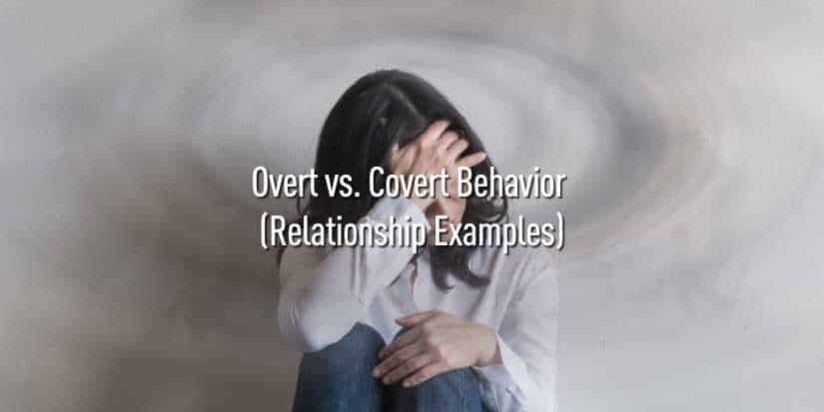It’s no easy task to understand overt versus covert behaviors and how they play out destructively within relationships. Yet, understanding is the key to overcoming. Covert behaviors are incredibly confusing and especially difficult to discern. The person within the relationship on the receiving end of covert behaviors often has no idea what is going on or how to respond effectively. But what many don’t realize is how significantly covert behaviors fool those on the outside of the relationship looking in. The confusion often causes those in the couple’s close community to react in ways that unintentially fuels the abuse and abandons the victim.
Join us as we unpack the confusion through defining covert and overt behaviors, providing examples of them in relationships, discussing how they impact those within the relationship and deceive those on the outside. By reading and learning, you will play a part in overcoming the destruction covert abuse causes.
Let’s get started.
Defining overt and covert behavior
In simplest terms, “overt” means “apparent”, or “visible”. “Covert” means “hidden” or “concealed”. Both behaviors are used to affect relationships.
Covert behavior refers to the internal thoughts or motives that result in outward overt actions. Overt behavior refers to the outside acts that follow the inside thought or intention and are apparent or obvious to others. Healthy relationships include covert and overt behaviors. So what happens when there’s abuse?
Covert Abuse
Covert abuse is actions that are not clearly apparent as abusive. The covert behavior behind the act is what makes them abusive.
Covert abusive behaviors are subtle, confusing, and hidden tactics that could be masked as concern, hurt, or misunderstanding rather than readily seen as abusive. Covert abusive behaviors are hard for anyone to detect. On the other hand, overt behavior is hard to miss.
But in an intimate relationship, the person being harmed has an even harder time recognizing covert behaviors because they are living in a separate reality from their partner’s reality. They want to believe their partner’s intention is to be loving, not controlling or manipulative. This makes it nearly impossible for them to recognize the toxic covert behaviors.

How overt and covert behaviors can be damaging to a relationship
Certain covert and overt behaviors can be damaging to any relationship even when it’s not abusive.
To illustrate, let’s look at a common scenario between parent and child. For several nights in a row, the child wakes up scared and crying because of a nightmare. I can still hear my mom telling me my nightmares were “just a dream” and not to worry about them, while I remained terrified to go to bed. Rather than comfort me in a time of extreme stress, Mom dismissed the experience altogether through her response.
The reality is that she was probably just tired and allowed her exhaustion to justify dismissing my feelings rather than nurturing me. She missed the opportunity to see, hear, and teach me. But Mom’s intention was to help me with my fear, not to hurt me. She was not abusive. Overt behaviors, even when not abusive, can harm.
The abusive parent continually minimizes the feelings, fears, and insecurities of their child as a means of power and control. With their self-esteem depleted over time, the child becomes more and more dependent on the parent. The narcissistic parent endeavors to increase the child’s emotional dependence on them so significantly that the child’s attention is always upon the parent.
Examples of overt and covert behaviors
What are overt and covert behaviors in relationships?
For example, an apology usually means that the person saying “I’m sorry” is actually sorry for their behavior. The covert thought behind an overt apology is remorse.

But a partial or false apology is also a covert behavior narcissists commonly use to manipulate a person’s actions or reactions. The covert thought behind the “apology” has nothing to do with remorse. Instead, the apology (the overt behavior) is being used to avoid true accountability and to deceive the victim into “letting it go”, taking the attention off of the abuser and their toxic behavior.
Unless you recognize the covert behavior, you will be deceived by the overt act of the apology. The deception enables the person causing harm to manipulate their partner and begin the cycle of abuse over again.
The best way to understand how overt and covert behaviors are used within abusive relationships is by taking a look at some common tactics covert abusers use. The following covert behavior examples are common in emotionally abusive relationships:
Joking
Joking is a harmful behavior that is regularly used. Joking isn’t always bad. But real and intelligent humor is never at the expense of another person. An entertaining joke that everyone can enjoy requires more creativity than sarcasm and put-downs which are aimed at one individual.
Some families make humiliation a sport. They may sit around the dinner table, picking away at each other’s insecurities to produce a laugh.
Or, perhaps one of your children makes a mistake at school and your family decides to make light of it through sarcasm and joking. Although your family might be used to this type of joking, it impacts your child deeply. It causes shame and insecurity, teaching the child to perform well in order to receive love.
Don’t assume your child doesn’t care just because they are good at deflecting or hiding the shame they experience.
Lying
Lying is when someone consciously or unconsciously withholds or alters the truth with blatant disregard.
Many people lie without being covert abusers. The overt act of lying is harmful to everyone regardless of the reason for the lie. When a lie is used because it brings the liar joy or satisfaction to deceive their partner and witness their confusion, it’s abusive.
In abusive relationships, lying is regularly used to avoid taking responsibility, being intimate, or resolving conflict.
Withholding
Withholding is one of the most damaging forms of covert abuse. Withholding takes place when an individual tries to control or dominate another person by refusing to authentically communicate, offer compliments or praise, or show physical warmth or connection to the other.
We see it most often when someone refuses loving physical touch, gives their partner the “silent treatment”, or refuses to celebrate their accomplishments.
The victim’s attempt at healthy confrontation usually results in some form of withholding. It’s not unusual for the abuser to refuse to speak with their partner for several days on end in response to an attempt at healthy confrontation by them. We often hear from survivors about how their spouses would leave them for several days on end without telling them where they were going or if they were safe.

It’s used as a form of punishment to the victim for confronting the abuser. Withholding puts the onus on the victim to resolve the conflict possibly by apologizing profusely when they did nothing wrong or begging the abuser to come home, talk to them, etc.
Withholding makes many victims feel desperate for connection and become willing to do anything to restore the connection, especially to let go of the issue which caused the need for confrontation. This response is the only thing that satisfies the covert purpose behind withholding.
Put-Downs
Another harmful tactic is Put-Downs. This happens when a person publicly punishes, verbally attacks, or criticizes the victim. It’s a form of abusive control or power that causes shame and humiliation in the victim.
Regular put-downs deplete the victim’s sense of self-worth and esteem leading to depression and isolation.
So, now let’s take a look at why it’s important to know various covert behaviors.
How covert and overt behaviors fool the outsiders looking into the relationship
It’s almost impossible for those who are outside of the relationship to identify covert behavior because the person’s overt actions are often believed to be what they seem – the apology is seen as an apology because the covert motive behind it is unknown.
Image Management
It becomes even more complicated for outsiders, or responders, to recognize covert abuse because the covert narcissist acts so differently in the public eye, often showing him or herself as a nice man or woman. So, friends and families find it hard to believe the person would have nefarious covert intentions to harm their significant other.
As a result, outsiders, even those closest to the one who is being harmed, often fail to understand the victim’s concern, possibly even believing the victim is being dramatic or overly demanding. They ultimately dismiss the issue and miss the opportunity to help someone in a toxic relationship.

Gaslighting
Gaslighting is another example. A narcissist will use gaslighting – for example, telling the victim their memory of an incident is wrong – to make the victim eventually believe they got it wrong and that the narcissist’s memory is correct when it is not. All the while the abuser is enjoying the victim’s confusion and using it to gain support from onlookers who eventually side with the abuser. The covert intent is to make the victim feel like they are losing their mind and to convince others that they are unstable.
Overt behaviors, on the other hand, are apparent even to strangers. Overt emotional abuse would include verbal abuse such as name-calling or cursing at your mate. Other overt acts include physical violence or sexual assault. You don’t need to be a close friend of the abuser to recognize the behavior as harmful. The inside thought is closely aligned with the outside action. When you curse at someone, that’s exactly what you intend to do.
The benefits of recognizing and dealing with covert behavior
Because it is so hard to recognize with confidence, covert abuse is hard to stop. The tactics are designed to impart self-doubt, extreme confusion, stress, and feelings of isolation to the victim.
Having to respond to covert behaviors consistently within an intimate relationship puts the victim in a state of prolonged stressful confusion, impacting their ability to think clearly and to react constructively to the abuse.
Once a victim learns the correct language and is able to name the tactics they face, they can respond more constructively. The clarity knowledge brings diminishes the level of confusion and stress the victim experiences.
Clarity
Clarity is the first essential step to healing. It allows the person who has been harmed to separate themself from the covert behavior and recognize it’s not their fault. It enables them to place responsibility for the harm on the abuser.
Through clarifying terms and definitions, all those impacted by abuse can name and identify the nature of the source of their stress, confusion, and traumatic symptoms. This is a key step towards being able to deal with overt and covert behaviors.
To help you quickly achieve clarity, check out our course Finding Clarity and Healing in Difficult, Confusing, or Abusive Relationships.
How to deal with overt and covert behaviors
This process empowers victims for the first time. They learn how to call out those behaviors specifically as well as begin to manage them by setting firm boundaries, adopting self-care strategies, or even choosing to leave the relationship temporarily or permanently in an effective manner.
Once a victim gains this clarity, the first step is to try to set a boundary against harmful covert and overt behaviors. Taking this step may take time and possibly work with a therapist to help the victim to rebuild their self-esteem and gain strength in using their voice to place firm boundaries. It’s important to have strong support, professional or otherwise, to identify the safest ways to respond to the abuse.
It’s important to remember the abuse may escalate when the abuser is confronted or the victim sets boundaries consistently. More obvious forms of emotional abuse such as forced isolation, financial control, jealousy, and other methods of overt control are more likely to lead to physical violence and extreme violence, particularly when the victim chooses to set boundaries or leave.

Getting help
It might be in the victim’s best interest to seek counsel from a domestic violence agency or another expert on domestic abuse about the safest way to confront the abuse or exit the relationship.
Even when firm boundaries are set, that doesn’t mean the abuser will take responsibility and change. Most often, someone who is entrenched in faulty thinking will be unwilling to make a change or admit they need help.
Their chances of transformation are greater if they have expert help from an expert. Statistically speaking, most abusers are unwilling to do the hard work transformation requires.
The importance of communication in relationships
Victims of these types of behaviors work much harder to have fulfilling and authentic conversations. Oftentimes, their work not only leads to dead ends but can backfire and be used against them through the various defensive tactics that abusers habitually employ.
When we desire healthy relationships, we will make good communication a high priority. What if instead of a false or partial apology, your partner told you, “I’m deeply sorry for hurting you. I will do everything in my power to never do that again.” And they actually try not to do the same thing again. Such simple statements can be the difference between healing and further harm.
Humble, loving, communication, and authenticity are key to healthy communication within any relationship. It’s critical each person in the couple acknowledges and values the other’s feelings, even when they disagree. Acts that demonstrate mutual love and respect towards each other and a heart to maintain a healthy connection make all the difference.








Where can I find the clarifying terms or the list that was talked about in the interview with Natalie Hoffman that will help me see what he is doing and call it out?
Hi Carrie – take a look at the free tools and resources page on our website. There are free downloadable PDFs you can take a look at. If you need more, reach out to us at email at info@themendproject.com!! 🙂 I believe Natalie also has those downloads linked from the podcast episode notes.